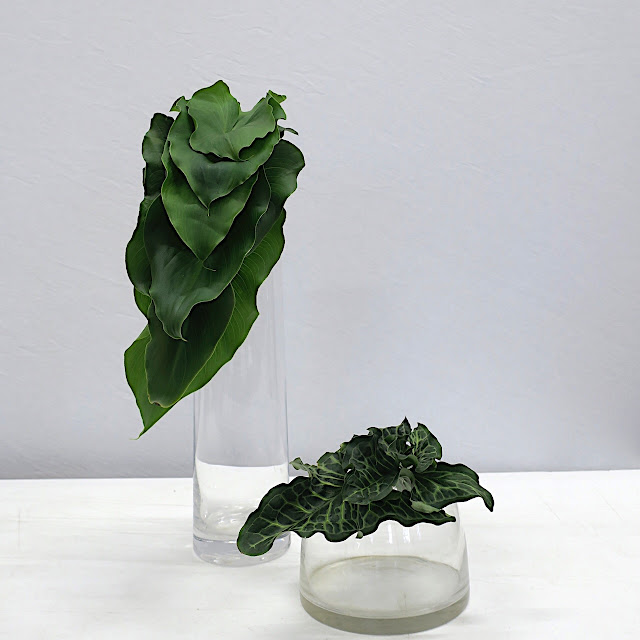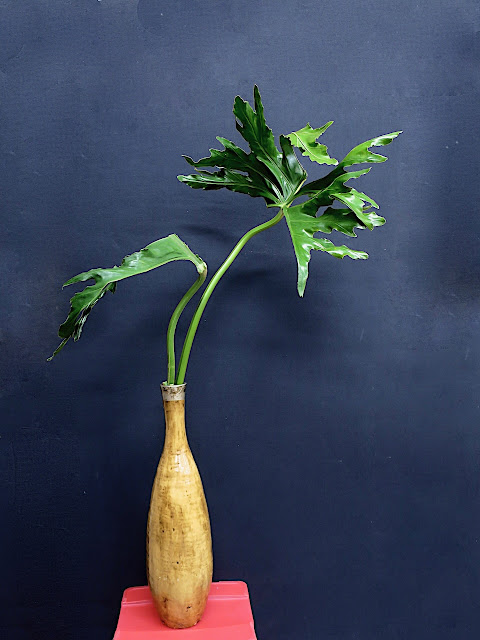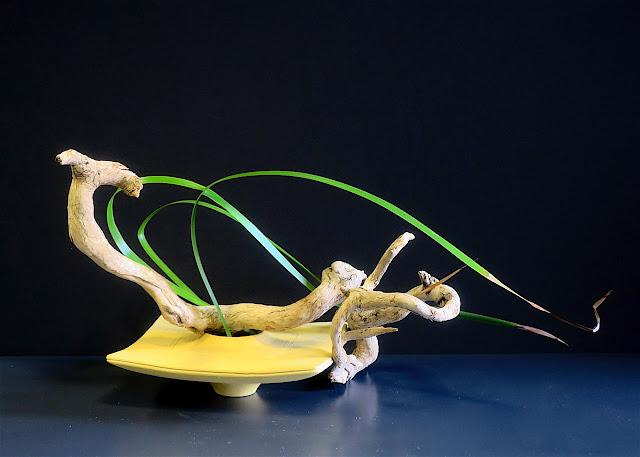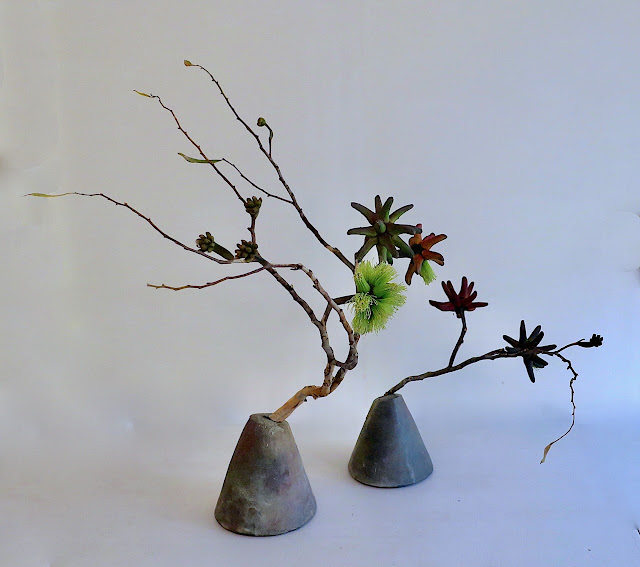TWO VESSELS : LEAVES ONLY
COOTAMUNDRA WATTLE: ACACIA BAILEYANA
During one of those sunny spells we had a walk along the creek path. To my surprise we saw this Yellow Tailed Black Cockatoo, quite low down in a tree. They seem to be a bit skittish when they are surprised in our garden. However, this female moved closer toward us along the branches, chomping through small branches as she moved. I must admit I felt somewhat intimidated by the demonstration of her beak's power and decided to continue walking!
In my Melbourne class...
...Eugenia made an ikebana using bare branches and contrasted them with fresh material. In this case deep red Asiatic Lilies. Her almost square box-shaped vessel is one she made at the Sogetsu Kiln in Echizen. It has a vertical slit at the top left which is helping support the branch which is outside the vessel.
...the prostrate Cootamundra wattle Acacia baileyana, has started to flower. These Acacias are one of the joys of winter as the yellow of this particular form is very vibrant and abundant. I decided to use it for my ikebana this week as I missed the opportunity last winter.
WIND
Editor's note: The orange flower in Maureen's arrangement two weeks ago (30th June) was incorrectly identified. It is a Tagetes not Calendula. Thanks to Fermi, my friend and plant-knowledge guru, for the correction.
In my Geelong class...
Maree's exercise was to make a 'Celebratory Ikebana'. She used Delphinium, Eucalyptus leaves, Tagetes and some wild Rapeseed Brasssica napus.
Christine was inspired by the curving lines of this unidentified Hakea from her garden. The contrasting material is an unidentified Banksia.
Ellie used the strikingly coloured 'Peach sticks', which I gather is a cultivar grown for the floristry industry. The flowering material may be Pieris japonica.
Three weeks ago, the guest presenter at the Victorian Branch of the Sogetsu School workshop was Ray Bywaters. She is the Director of the South Australian Branch of Sogetsu and last year was the recipient of the Norman and Mary Sparnon Ikebana Endowment Scholarship. This is the scholarship that funds active Australian Sogetsu teachers to attend the Sogetsu Head Quarters in Tokyo for three months of classes.
Ray chose interesting non-curriculum themes for her two workshops. In the first workshop members were asked to make an ikebana in response to the compound Japanese character, “花鳥風月“ Kachoufugetsu. The expression evokes the appreciation of natural beauty. Its literal translation being; flower, bird, wind, moon. We were encouraged to make a freestyle ikebana drawing on any of the ideas these words evoked in us.
The idea of wind appealed to me and I used a twisting branch of Moonah Melaleuca lanceolata. This small tree grows on the clifftops around Torquay and, because of the strong prevailing winds, it develops twisting forms.
ACANTHUS
Lyn's ikebana featured a branch of London Plane Tree Platanus x acerifolia. Although not quite bare, this branch certainly had a late autumn look. On the right side of the vase are some stems of Cotoneaster with red berries attached.
Louise used bare branches from a Nectarine tree Prunus persica. The branches on the left are unidentified. At the mouth of the vase is a small spray of Sweet Pittosporum Pittosporum undulatum leaves and berries.
Róża used a bare branch of Coast tea tree Leptospermum laevigatum which she positioned to emphasise its sweeping lines. The small contrasting fresh material was Pincushion Hakea H. laurina.
Pamela's materials were not specifically identified. The bare branch was positioned to exploit the counter movement of its lines. The small focus of fresh materials includes a red flowering Eucalyptus
The starkness of Norma's bare branches was highlighted by the small mass of orange-red Manchurian pear Pyrus ussuriensis, which has the function of visually holding the branch lines together and connecting them to the vase.
In the Melbourne class the students' task was to make an ikebana using one material only.
Aileen's material was Bushy Yate Eucalyptus lehmannii. Having first removed all of the leaves, she set the material in two unusual ceramic vessels. The branches have irregular curving lines and feature two stages of the flowers buds and one fully opened flower.
In the garden, the red flowers of the Swan River Pea Gastrolobium celsianum caught my eye in the morning a couple of days ago. The plant is growing beside the garden steps and the early sun was dramatically back-lighting the flowers. It is such a joy to have these flowers open in the middle of winter.
...has recently produced its leaves for the new season. This is one of my favourite large-leafed plants and I am delighted to have it in our garden. It has a particularly beautiful form and I am not surprised that in ancient Greece it was used for the design of Corinthian column capitals. I have been monitoring its growth and decided that I would use this leaf material for my ikebana.










.jpeg)
























